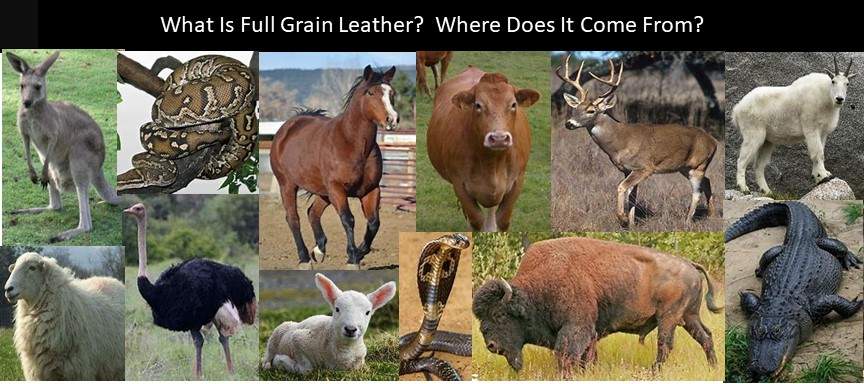
We Explain What Full Grain Leather Is So You Can Buy The Best Leather Goods. The Look, The Feel, The Smell, The Strength, The Weight, The Thickness And The Tanning Are Key To Understanding Full Grain Leather.
The Following Full Grain leather Topics Are Covered
What Is Full Grain Leather?
Full Grain leather is the layer of skin just below the hair or fur on animals and the layer just below the scales for reptiles but above the loose fibrous and flesh layer.
Full Grain leather does not include all three layers of the skin. The grain comes from the bottom layer of the epidermis just below the hair and the top layer of the Dermis, known as the Papillary Dermis and does not include the Hypodermis.
So what are the three layers of skin to make leather?
The Three Layers Of Skin And Leather
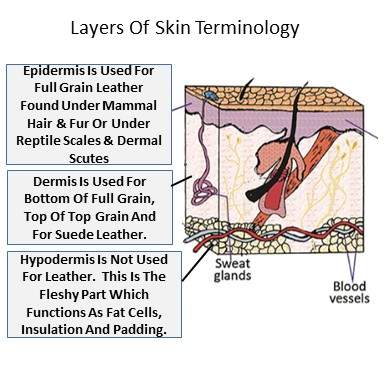
- The first layer of the skin, the outer top layer, is known as the Epidermis. It contains the hair, fur and scales on the top with the grain layer underneath. It is used for Full Grain leather.
- The second layer is known as the Dermis. The Dermis is split into two layers, the Papillary Dermis on the top and the Reticular Dermis on the bottom. The thin upper layer, the Papillary Dermis is very dense giving Full Grain structure. The thick bottom layer, the Reticular Dermis, is less dense without grain. Both layers are used for leather; however the Reticular Dermis is only for Split Leather known as Suede.
- The third layer, the lowest layer of the skin is known as the Hypodermis. It is not used for leather.
Is Full Grain Skin Or Leather?
Full Grain can be called skin or leather. The term ‘Skin’ is used to refer to young growing animals that have a height less than three and one-half feet. Such animals include calves, lambs, kids, fawns, and colts. The term ‘Leather’ is used to refer to grown animals such as cows, sheep, goats, deer and horses.
It is appropriate to refer to a Full Grain finished product as “Leather”. Using the term Full Grain Calf Skin Leather helps to quickly identify the product as soft feeling because young animal skin is softer and suppler.
Where Does Full Grain Leather Come From?
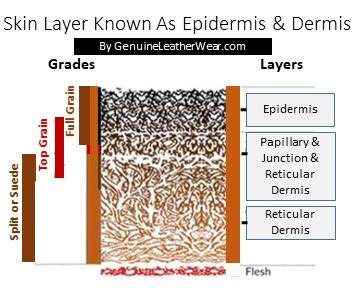
Full Grain leather comes from the Epidermis layer under the hair, fur or scales and the top layer of the Dermis known as the Papillary Dermis. The bottom layer of the Epidermis contains the grain and the Papillary Dermis is the structure for the grain giving it strength because of its closely woven fibers.
Top Grain leather comes from the lower part of the Papillary Dermis which has closely woven fibers and the upper layer of the Reticular Dermis which is made of less closely woven fibers.
Split leather, also known as Suede leather, is the Reticular Dermis layer which has no grain but is comprised of fibers.
So how do you know a piece of leather is Full Grain?
The Full Grain Leather Look
The Full Grain Leather Look may not be what you are expecting. It does not have a smooth perfect uniform appearance because Genuine Full Grain is leather in its natural form without alteration; it may have blemishes because animal hides and skin get scratched and torn during a lifetime.
Obtaining full grain leather is challenging because blemishes may be too great to use as they naturally appear. Rejected natural grain leather with blemishes can be sanded and buffed on the grain side to remove the marks and imperfections to create corrected grain leather. Sometime the layer with the blemishes is split off and Top Grain leather results.
Top Grain leather does not have a natural grain. Any grain like look that appears is an embossed fake grain pattern.
Since animal hides are so susceptible to imperfections, is there a way to reduce the imperfection?
How To Reduce Leather Imperfections
There are two ways to reduce the number of imperfections appearing on Full Grain leathers. 1) Use young animal skins such as calf, kid, and lamb because young animals have not encountered as many scratches and blemishes during their limited short life or 2) Control the environment where the animals or reptiles live by creating animal farms.
Cowhide is the least prone to getting torn than any other animal leather.
Does All Full Grain Leather Look The Same?
The Real Genuine Leather Full Grain look depends upon the animal or reptile. Here’s a comparison of some of the Full Grain Leather looks.
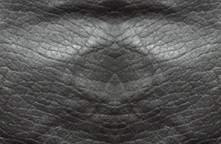
✓ Buffalo, also known as Bison, grain is more pronounced than cow grain because it has wider and thicker fibers which make it look course. It has a distinctive pebbled uneven grain that lends itself to rugged beauty.
✓ Horse leather is a courser grain and is less porous than cow leather.
Dyed horse leather tends to appear less uniform in color than cow hide.
✓ Cow leather shows more grain than calfskin, sheepskin, goatskin and lambskin.
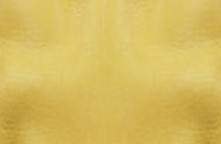
✓ Deer skin has a smoother grain look than cowhide.
✓ Camel leather has a more distinct gain than cowhide. It has a faint vein effect running through its surface. Cow leather has a smoother grain look.
✓ Kangaroo leather has a smooth surface and looks much like calfskin leather.
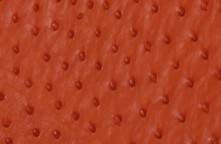
✓ Ostrich leather looks very unique with its raised points on its hide. The bumps on the skin are the spots where the quills or feathers were growing. These bumps form a diamond shaped crown. It’s the randomly sized quill marks which gives ostrich full grain leather such a luxurious look as a finished product.
✓ Reptile skin is made up of many difference layouts, shapes and sizes. No snake, crocodile or alligator species skin is the same.
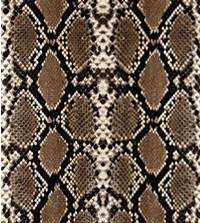
✓ Snake species skin is identified by scale formation on the head, back and belly. Small scales are found dorsally on the body in several rows. On the abdominal part of the body scales are wide and transversely positioned.
✓ Caimen skin has more pores than the Nile crocodile which gives a more dimensional look.
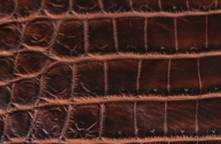
✓ Nile crocodile skin has a smoother and cleaner look than Caimen skin. Only the belly side and skins are usually used for crocodile leather because the back skin is too hard because of the armor.
✓ The surface of alligator leather has a natural enamel look. Only the soft belly skin is used for leather.
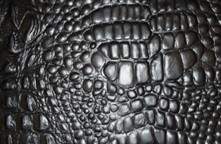
✓ Crocodile and alligator skin look very similar because they both have larger rounded square scales across their bellies which is the softest part of the skin. The big difference between the two skins is the transition between the large and small scales. For Alligator skins there is no transition; it happens suddenly. For Crocodile skins the transition is gradual.
So if the Full Grain Look difference is different for each animal and reptile specie, what about the feel?
The Full Grain Leather Feel
Just like the look, the leather feel is based on animal and reptile type.
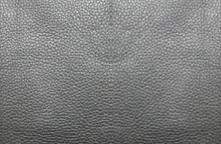
✓ Cow leather feels smoother than camel. Camel leather has a harder finish which resists scuffing.
✓ Buffalo leather feels more buttery soft than cow leather. During the tanning process buffalo is not as soft as cow leather. However after the tanning process buffalo leather is softer than cow.
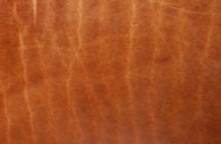
✓ Horse leather feels more ridged than cow leather.
✓ Kangaroo leather feels fine and uniform compared to cow leather.
✓ Lambskin is the softest type of leather. It’s light, airy layered structure gives it an exceptionally soft, velvet-like texture even though it is not as durable.
✓ Deerskin and Goatskin feel softer than cow leather because of the presence of lanolin in their leather.
✓ Crocodile and alligator skins feel softer than Caimen leather.
✓ Alligator skin is softer and smoother than crocodile skin.
The leather look and feel are different so what about the smell?
The Leather Smell
The smell is basically the same for all leather. The best natural leather smell results when vegetable tanning is performed and no chemicals are used; vegetable tanning leaves no residual chemical smell. Pure, naturally treated leather has a mild smell that is easy on the nose. Chromium tanning can leave a distasteful smell.
Full Grain Leather Strength
Just as the look and feel of full grain leather varies by specie type, so does its strength.
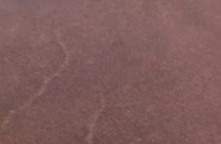
✓ Kangaroo leather is lighter and stronger than the hide of a cow or goat. It has 10 times the tensile strength of cowhide and is 50% stronger than goatskin.
✓ Based on weight per square inch, ostrich leather is stronger than cow or goat leather.
✓ Goat skin is tougher than cow leather and very supple.
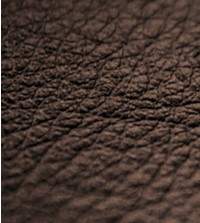
✓ Camel, buffalo and horse leather is stronger than cow hide.
✓ Cow leather is much stronger and thicker than calfskin. It also repels moisture, and retain shape for a long time, resist heat and sun damage. Vegetable tanned cow leather products can last at 40 years.
✓ Deer leather is very durable and abrasion resistant, giving it a high level of longevity; however not as long as cow leather..
Having compared the strength of various animal leathers, let’s see if there a correlation between strength and weight.
Full Grain Leather Weight
Let’s see how the weight of Full Grain leather types compare.
✓ Buffalo leather is heavier than cow leather.
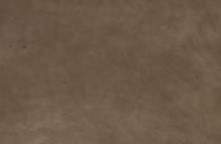
✓ Deerskin and lambskin are lighter than cow leather. It has the natural ability to trap air between its layers, making it feel even more lightweight and softer than it already is.
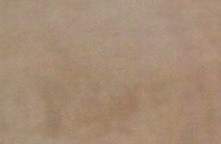
✓ Goatskin is lighter weight than deerskin
So there not a consistent correlation between weight and strength. Kangaroo leather is very strong, but yet it is very light.
So is there a correlation between leather strength and its thickness?
The Full Grain Leather Thickness
The thickness of Full Grain leather depends on the animal hide it originated from, the depth of the leather remaining after the split leather is removed and the purpose for which it is used.
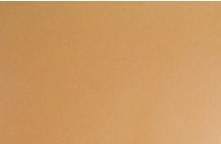
✓ The Full Grain layer from younger animals is thinner than that from their older parents. This is true because its fiber structure is more tightly interwoven
✓ Leather from animals confronting the wilds day after day is thicker than that from domestic animals.
✓ Skin from the bellies of reptiles is thinner than that covering their back.
✓ A Kangaroo Full Grain layer is very thin because its tensile strength is found throughout its depth.
✓ A Buffalo Full Grain layer is up to three times thicker than a cows.
The Full Grain leather layer thickness plays a significant role in determining which leather is most appropriate for which leather product.
Which Leather Thickness Is Best?
The Leather Industry sets guidelines as to which leather thickness is best for each product type. Find below the given leather thicknesses that are ideal for making specific leather products.
✓ 0.5 to 1.2 mm leather is best used for making leather jackets, pants and gloves.
✓ 1.0 to 2.5 mm leather is best used for making wallets, leather bags, shoes, boots, jackets, and book covers
✓ 2.0 – 2.5 mm leather is best used for making heavy duty leather bags, travel bags, and leather straps
✓ 2.8 – 3.5 mm leather is best used for making belts, soles of shoes, and knife sheaths
Apart from the fact that Full Grain leather has characteristics of its own as mentioned above, how the leather is tanned has a great impact on these natural characteristics. What is the best way to tan leather so its Full Grain is preserved?
The Leather Tanning Process
The type of leather tanning used affects Full Grain leather and the environment. The most common types are vegetable and chromium.
Vegetable tanned leather, the oldest process, is exposed to a tanning process which uses natural ingredients such as the bark of oak, chestnut, and mangrove trees. These natural plant extracts leave rich tones of natural brown in the leather. In addition it does not weaken the fibers by harsh chemicals and thus the finished leather is stronger.
Vegetable Tanning along with proper care results in leather lasting more than a lifetime. It complements the aging process of developing a natural patina over time as the product is worn or used. Because the ingredients used are natural they have no impact on the environment nor does a discarded leather product.
Chromium leather tanning, the faster process completed in less than two weeks, exposes the leather to chromium salts and tanning liquors. The salts and liquors are an environmental hazard thus some tanneries are reverting back to vegetable tanning. The chromium tanning process does change the fibers of the leather making it softer, thinner, more water resistant, and capable of absorbing dyes more uniformly; however the leather does not age with increased patina.
When shopping for Full Grain leather products it is best to look for those that are made from vegetable tanned leather. If the label mentions the leather has an Aniline finish, this is even better.
The Best Full Grain Leather Finish
The best Full Grain finish is aniline dye. It leaves the leather in its most natural looking state because the grain of the leather remains visible. An Aniline finish leaves the leather completely transparent as well as soft and luxurious. Often raw (un-emulsified) oil or a combination of raw oil, blended with emulsified oils is used to hydrate the leather allowing it to flex, be lubricated and be more water resistant. This is harmless.
Buying an aniline full grain leather product offers these advantages.
- It gives assurance the leather is very high quality
- It means the leather grain and surface is not altered
- It means the natural markings of the leather are not hidden.
It is the Real Genuine Leather Deal!
The second best Full Grain finish is semi aniline dye. Because it is semi-transparent, the grain is not as distinctly visible because the finish does obscure the surface somewhat.
Owning a bag that is made of aniline vegetable tanned leather, requires little care; however it is always wise to know if there are some maintenance tips that can preserve the bag even further.
How To Care For Full Grain Leather
Full grain leather requires little care. Here are a few quick tips.
✓ Simply wipe the product with a cloth every now and then to avoid the buildup of dust and dirt.
✓ Keep the product away from direct heat as heat can dry out the leather.
✓ Keep it in an environment where the humidity is about 40 – 50 percent so it can maintain its essential moisture.
✓ Use leather protectants and sealants to aid the prevention of natural oils from escaping and providing a barrier for everyday dirt and grime. Make sure the protectants and sealants to not alter the natural grain look.
✓ Use caution when trying to waterproof Full grain leather. It can never be 100 percent waterproofed. It is a permeable material and needs to breathe.
✓ Remember Water proofing sprays may alter the color and surface of the leather.
✓ Do not force dry leather if it gets wet. Let it dry naturally. Do not dry it with a hair dryer.
Full grain leather is extremely durable. With the correct care and usage, it can last decades. Wearing and using leather is still in vogue and has been for centuries.
Full Grain Leather Production
Full grain leather production is still alive and well. The eight biggest producers of full grain leather in the world are: the USA, Argentina, South Korea, India, Russia, Italy, Brazil and China.
Many leather brands have emerged throughout the world.
To save you time we have compiled a list of brands using Full Grain Leather.